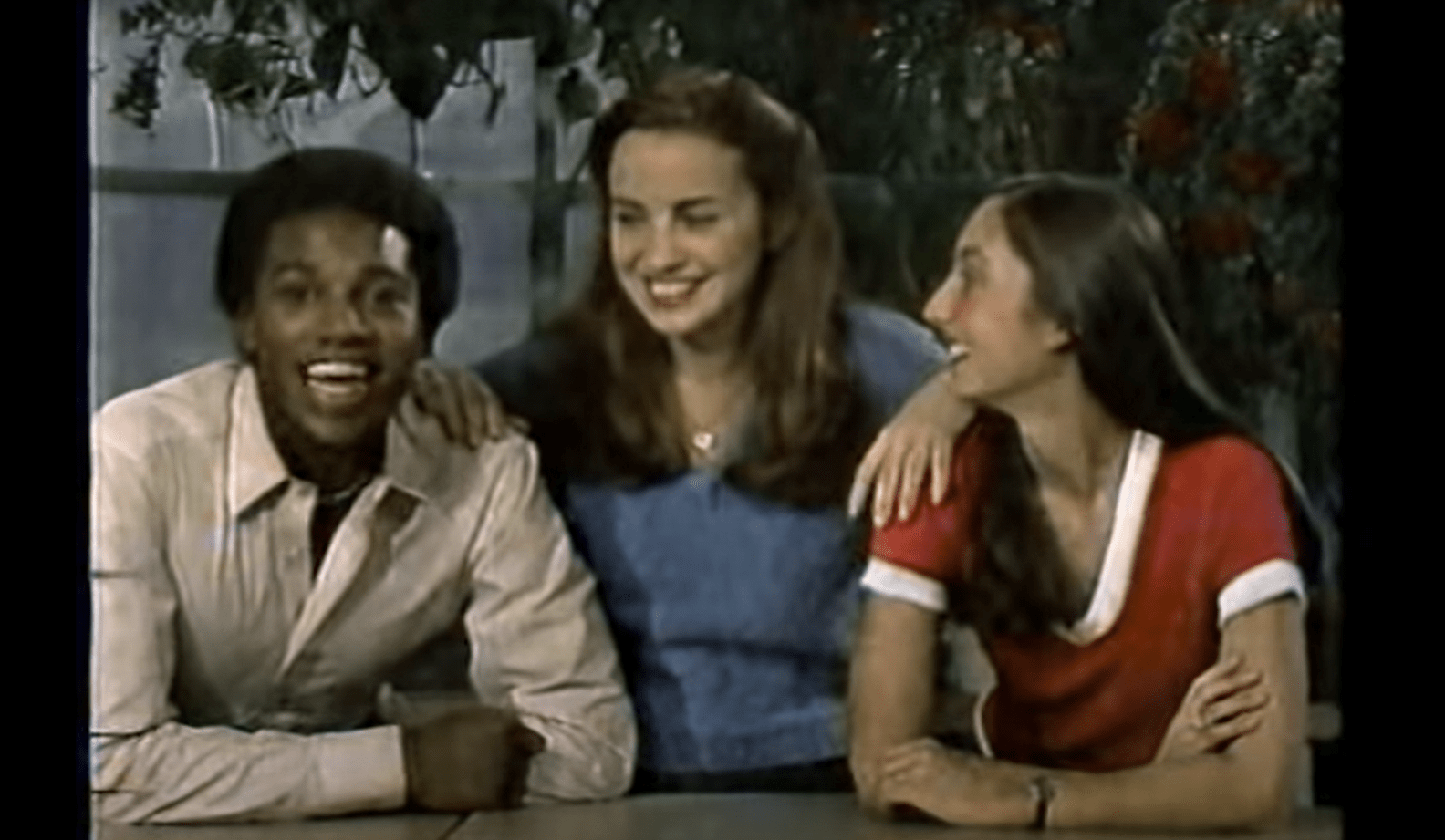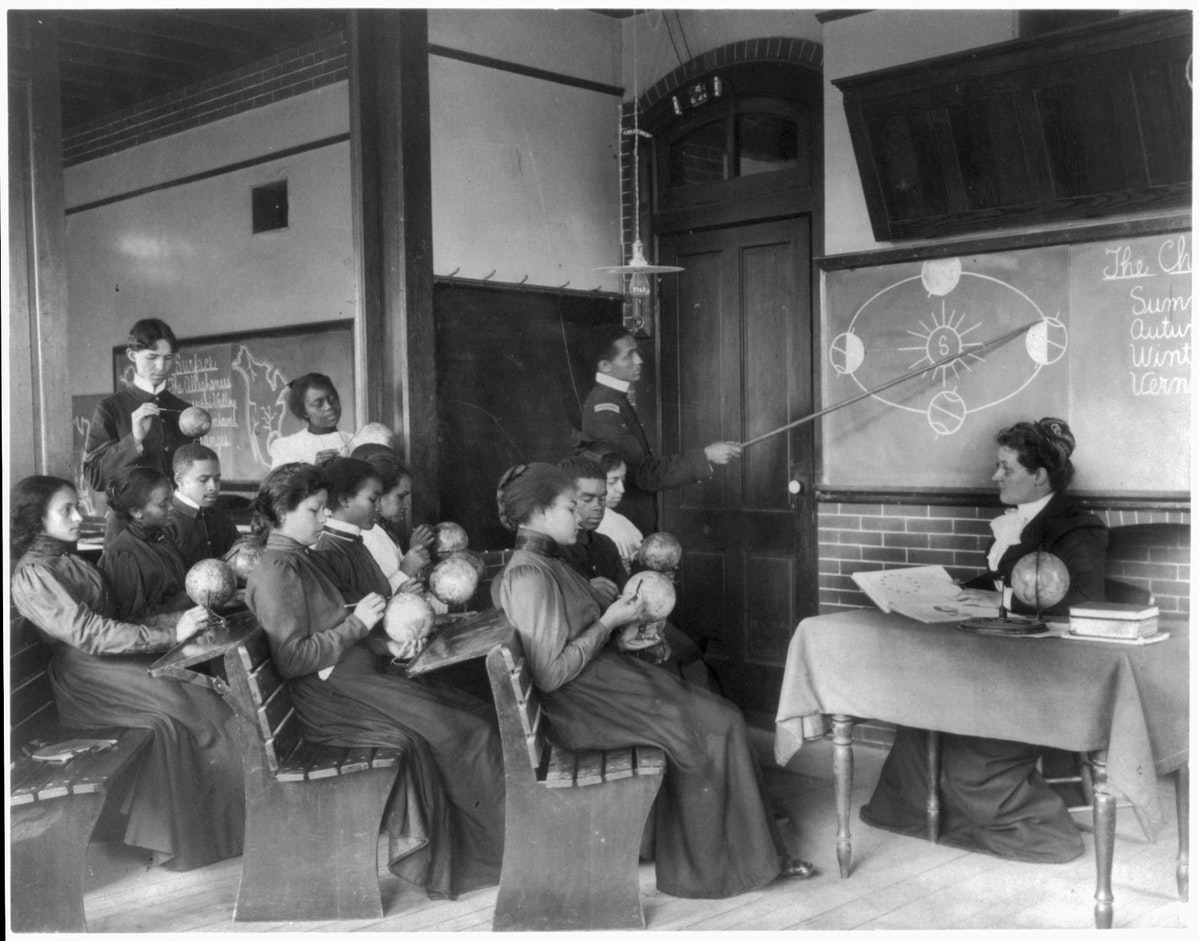From Sputnik To Twitter, The History Of Science Communication
Instead of yesteryear’s dry and dusty lectures, science communicators are creating new and exciting ways to engage with science.

The original cast of 3-2-1 Contact! From left, Marc (Leon W. Grant), Lisa (Liz Moses), and Trini (Ginny Ortiz). Screenshot via YouTube
This story, which was produced in partnership with Johns Hopkins University, was originally published on Massive Science.
“Um, so I’m Lucianne and I’m an astronomer and I’m here to answer any questions you might have. We can talk about, uh, really whatever you want to talk about.”
“Cool, you’re an astronomer??”
Astrophysicist Lucianne Walkowicz, before COVID time, would spend an occasional hour at the Space Visualization Lab at the Adler Planetarium in Chicago. The lab is filled with displays of space images, videos, and interactive displays, all connected to a tablet that the presenting scientist can change easily. Think of it as a dynamic exhibit.
In this lab, every day, different scientists come and engage in “Astronomy Conversations.” Audiences ask questions and can sometimes determine the path of the conversation. The lab is designed to work for different interests and needs. Some attendees walk around the lab while the scientist is speaking, watch a 3D display of a galaxy; others touch a 3D printed model of a nebula, and some listen to the sound, played from a speaker, of two black holes merging.
The conversations can build a relationship between the scientist and the audience. Walkowicz’s audience asks about the difference between black holes and dark matter or Walkowicz’s opinion about the movieInterstellar. Audiences also get to talk about how they used to come to the planetarium when they were kids. Engaging the public beyond one-way lectures is a science communication strategy that many scientists like Walkowicz are deploying more and more.
However, the state of science communication has not always focused on engaging people. Instead, imagine walking in museum halls filled with displays of labeled artifacts, where the most engagement you have is, reading the labels or opening drawers to see what is inside! In the 1960s museums began developing more engaging and interactive environments to elicit more critical thinking and encourage the joy of discovery.

A class in mathematical geography studying earth’s rotation around the sun, Hampton Institute, Hampton, Virginia, 1899. Credit: Library of Congress
Sputnik changed things. The launch of the small, beeping satellite by the USSR in 1957 was one of of the main events that garnered more attention to the public education of science. This led to scientists demanding education reform to help train the next generation of scientists, in response to the public demand for more awareness of the space race. So, in 1958 a movement for that reform began to move from more everyday science topic education to more focus on hard sciences, says Ingrid Ockert, historian of science in media.
One of the most important milestones in science communication post WWII, says Ockert, was that of John Hopkins Science Review (1948-1955). It was the first science show broadcasted nationally. The show was written, co-written, and hosted by Lynn Poole. Originally an artist and a dancer, Poole became a journalist and eventually Johns Hopkins’s director of PR. He not only brought different guests such as doctors, chemists, and engineers for interviews, he’d also invited non-scientists such as medical illustrators or animal trainers to talk about scientific topics. This format, and Poole’s background, made the show very different from the dry lectures that most people saw science in.
This is particularly important, considering what research tells us about effective communication. For the longest time, scientists thought if they just teach people about science and provide information, audiences are going to be on board. In other words, teaching facts equals changing attitudes and behavior. But if there is one thing we have all learned during the time of COVID is that, facts are not enough.
This model, implying that things will be “better” after a knowledge gap is “fixed” is called the deficit model of communication. But facts on their own might fail to change minds, and in some cases, they might even backfire and get the audiences to disagree even more. Engaging an audience, building a relationship and trust with them, telling good stories, and immersing them in a world filled with the appropriate emotions go so much further than just facts can.
Poole’s show not only focused on information, but also engaging the audience with science and himself. Later, Watch Mr Wizard (1951) became a hit as a science show in the U.S. aimed at kids. Ockert notes, this show is specifically aimed at kids becoming excited about science.
In 1962 Rachel Carson published her book, Silent Spring describing the effect of pesticides on nature and bringing to the public topics on environmental concerns. The book, also inspiring a whole episode on CBS, inspired environmental movements and a fight to protect the environment. The Silent Spring, referring to the silencing of more and more birds due to environmental pollution, is one of the factors that lead to the establishment of EPA in 1970.
In 1974 NSF created their first science show, NOVA, a program that highlighted the connection between science and society. NOVA produced a range of videos including interviews with researchers, and explainers of scientific phenomena and discoveries. Today NOVA is the longest-running science series in the U.S., and has expanded to include short digital videos, a podcast, digital publication, game labs and initiatives to train the next generation of science communicators.
Around the same time (1973) the 13-part British documentary series Ascent of Man debuted. It provided a new, narrative style used by many other shows to come (like Carl Sagan’s Cosmos). In the Ascent series, Jacob Bronowski used a personal, more storytelling-approach to take the audience on a journey, answer questions, and get a visual experience on the way. Similarly, Carl Sagan becomes a charismatic scientists that seem to build a relationship with his audience. What makes a scientist trustworthy, in addition to their competence, is their warmth: showing their honesty, friendliness, their ability to respect others, listen to others, and care for them. Sagan, with his genial, neighborly manner, built a trusting relationship with the audience, inspiring generations of scientists to come.
However, through all these years with all the progress, most science communication programming was limited to white male hosts and frequently stereotypical depiction of people of color. In the 1970s, the NSF tried to bring more diverse talent to the screen. One example is the 1980s television science series for children, 3-2-1 Contact! produced by the Children’s Television Workshop (CTW, the same organization behind Sesame Street). Hosted by Lisa (Liz Moses), Marc (Leon W. Grant), and Trini (Ginny Ortiz), Contact! had a different approach from many other shows before, aiming to coax audiences to think like a scientist, says Ockert.
Contact! has been important in many ways, not only in terms of representation, but also its use of science communication and audience research. CTW had dedicated research teams for each program it produced to conduct audience research. The research team for Contact! (Milton Chen, Hylda Clarke, and Barbara Myerson Katz) assessed children’s preexisting attitudes about science and how they were shaped by films and TV shows, and, children’s bias toward scientists. These assessments were later used when writing the show scripts as researchers had a seat at the production table. Their research went right into children’s homes, according to an an article by Ockert in Physics Today:
“They even had at their disposal a new interactive technology called the Program Evaluation Analysis Computer, a system of individual remotes that children could use to register their likes and dislikes and send them to a central console.”
Communication research and SciComm were now firmly linked. These efforts are also reflected in medical fields, where similarly funding is provided by NIH to research projects that examine the effect of science communication tools such as media programming on audiences, patients, or health care professionals.
The medical field especially has been integrating science/health communication training in their programming as doctor-patient communication is a part of everyday health practice. Organizations such as The Alan Alda Center for Communicating Sciences provide training for scientists and health professionals through improv and empathy training and many universities offer courses in health communication to their students. Additionally, science communication researchers have also been collaborating with policy-makers to address public health issues, as lately also witnessed in the case of COVID.
In 2021, SciComm is using new technology to involve the audience in storytelling. Two such technologies are AR and VR. Augmented reality (AR), like an Instagram filter, is a more affordable way to help the audience engage with the world around them, because it uses a device they already have in their pocket, says Wes Della Volla, Founder & Connector-of-Dots at Meridian Treehouse. For example, National Geographic’s Spark AR allows you to see yourself as a climber on Mount Everest. On the other hand, virtual reality (VR) can take you out of your world, and to a place you have never been. That would need a headset and a deeper immersion in the new environment, such as The Hydrous’ IMMERSE VR.
A more participatory method of engagement in science are citizen science projects. One scientist can’t catalog a million pictures on their own, but a million people can, says Grace Wolf-Chase, co-creator of the Milky Way Project (MWP). While computers are great at many things, they are not so great at recognizing patterns. In the MWP, scientists needed human eyes to look at their thousands of pictures and classify what they see. Over 20,000 volunteers completed more than 4 million classifications over the lifetime of the Milky Way Project. Papers coming out of these projects acknowledge the volunteers, and in some cases even include them as coauthors. Even though citizen science projects have been in place since the 1950s—such as the 1956’s Operation Moonwatch work to observe and document satellites—these projects are now an integral part of modern day scientific research in fields from astronomy to cancer research.
If SciComm has been historically white, social media has been an important platform to go around gatekeepings and provide a more democratic space. One SciComm social media star is Raven the Science Maven (aka Raven Baxter), who uses different social media platforms from YouTube to Twitter to produce entertaining science content, discuss science and society, and even her every-day life. Baxter’s authenticity easily comes through her content, from her tweets on making an earth sandwich, or her experiences as a black woman in STEM, to her music video about antibodies. She funded and hosted initiatives such as BlackInSciComm and formed a community for more diverse science communicators to share their experiences and to establish a sense of belonging.
It’s for good reason we call academia the ivory tower, it implies that it’s above others and cut off from the real world. This is a toxic notion that can only contribute to distrust for science and for science to become irrelevant in certain instances. By continuing to do things the way they have always been done, we also lose the attention of many, especially those who can’t see themselves in science or don’t have access to it.
Reyhaneh Maktoufi is a DC-based, Iranian researcher and science communicator. She is the co-producer, host and illustrator of PBS|NOVA’s digital series Sciencing Out, a mini-series on women in history who have used different strategies to communicate their science.